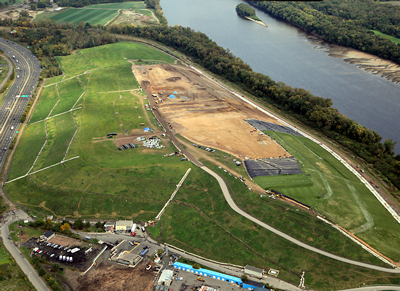
The geosynthetics field had a brief foray into system-based, solar energy-generating landfill covers (2009 – 2012), but the waste management market was not fully ready for such a change. Still, the economic advantages of exposed and alternative capping systems (vs. traditional, thick, soil-covered caps) and the long-term performance indicators meant that it would probably not be too long before solar landfills returned.
They have.
At the end of last week, the renewable energy company ISM Solar Solutions announced an agreement with Watershed Geo™—inventor of the ClosureTurf™ capping system—to bring solar landfills back to the market.
The two companies will now “design, develop and construct utility-scale solar arrays” for use with current and future ClosureTurf™ installations.
A BRIEF HISTORY OF SOLAR LANDFILLS
In 2009, the first exposed geomembrane “solar-landfill” cover was installed with thin-film photovoltaic panels adhered to the geomembrane surface. The 5-acre pilot project was unveiled at the Tessman Road Landfill (San Antonio, Texas). The system utilized a TPO geomembrane from Firestone.
Not long after the project, Carlisle established Carlisle Energy Services and developed a more commercial-scale system of solar-geomembrane covers. The 45-acre installation on the Hickory Ridge Landfill (Atlanta, Georgia) was a major milestone.
However, the general waste management market was not fully prepared to adopt such a new cover system. Carlisle closed the division.
Yet, alternative capping systems have continued to make headway, despite the temporary absence of solar energy-enhanced, exposed systems.
The ClosureTurf™ system has been the most noted, having enjoyed the support of Watershed Geo™ and Agru America. The system bonds synthetic turf to a geomembrane in a composite, capping solution for waste management, brownfield remediation, general site development/erosion control, and much more.
In waste management, it has been used on significant scales, such as for covering the 65-acre Crazy Horse Landfill (Salinas, California).
The utilization of synthetic turf on the surface has been a unique way to give the site’s a far more natural look, which, combined with solar energy, should be quite welcomed in what is currently known as the “solar brownfield” market. A number of small-scale project have installed hard solar panels affixed to concrete bases on soil-geosynthetic caps. A few have incorporated synthetic turf.
Now, a partnership with a bit of muscle will bring this solar greenfield idea into the field.
PARTNERS WITH PURPOSE
In an ISM release, the company outlined three environmental benefits that would steer the partnership’s designs:
- Creating permanent protection for aquifers and drinking water supplies from the hazardous materials and soil erosion associated with landfills and brownfields
- Developing cost effective, utility scale Solar Power to reduce reliance on fossil fuels and provide a clean source of energy for decades
- Repurposing landfills and brownfields to develop solar, while eliminating the need to cut down forests, place large arrays in neighborhoods or destroy family farms
For more information, visit www.ismri.com or www.watershedgeo.com.
– Chris Kelsey, Editor, Geosynthetica












